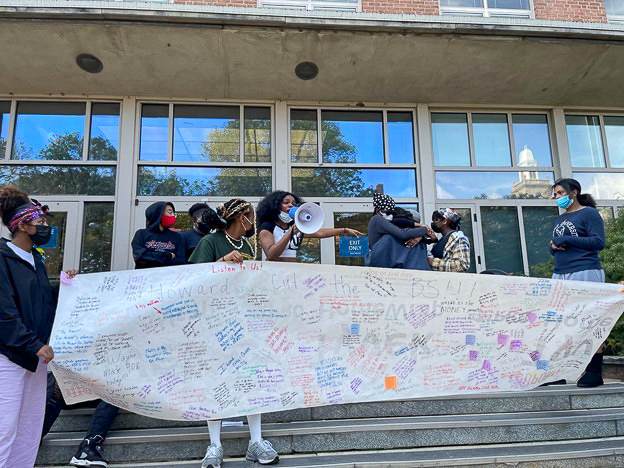Howard University Protests Expose Years of Failed Leadership
Recent protests from Howard University students regarding unhealthy living conditions highlight the need for students’ voices to be heard on college campuses. As a prominent HBCU, it is especially important for the Howard administration to acknowledge the voices of the students who they historically work toward uplifting.
For more than two weeks, Howard University students have been protesting unacceptable living conditions on their campus. Students have noted mold, insects, rodents, leaky ceilings, flooding and other issues within on-campus housing.
Students have started a sit-in at the school’s Blackburn University Center, a usual place of congregation for students’ social activities. The sit-in began on Oct. 12 and quickly gained traction with the creation of the #BlackburnTakeover on social media.
Through social media, students have issued a list of demands for the school’s administration. These demands include the request for an in-person town hall meeting with President Frederick and administration, permanently reinstating all affiliate board positions, an outlined housing plan for Howard leadership and legal, disciplinary and academic immunity for all protest participants.
Kymora Olmo, a freshman at Howard, has been camping out for more than two weeks. Like many other students, Olmo will continue to do so until the demands of the movement have been met. She spoke to NBC News, saying that camping outside has been miserable, but with the help of the local community tents and heaters have been provided.
“So the nights are getting more comfortable, but they’re not getting warmer. You know we don’t want to be out here until November, but if that’s what it takes, then that’s what it takes,” she explained.
Students are working hard through in-person protests and social media to make sure future generations attending Howard University do not have to face these same issues. Until their demands are met and acknowledged fully by the university’s administration, students are not going to let up.
The Howard administration has faced a lot of criticism concerning their leadership and their relationship with their students — and these are not new issues. The lack of leadership from Howard University has created unsafe conditions for the students that they claim to be actively working to support and protect.
Many are asking: how did Howard let this happen? How did Howard allow mold in thirty-eight dorms on campus and flooding to be a consistent problem for many students? And why are Howard officials ignoring students’ demands? As a school that requires students to pay upwards of $12,000 a year for on-campus housing, these unsafe living conditions are unacceptable.
Howard University leadership says that mold and other unhealthy conditions are an isolated issue, claiming they have only been witnessed in a minimal amount of dorms. University President Wayne A. I. Frederick communicated that these housing issues were merely the result of wet and humid conditions in buildings that have not been used in over a year due to the pandemic.
These issues have occurred consistently throughout Frederick’s time as President of the university. In 2016, 2017 and 2018, three individual protests took place at Howard University regarding the same issues being protested today. The 2018 protest consisted of a nine-day sit-in until student demands were met.
Similar protests have been occurring at Howard University even before Frederick’s administration. In 1968, the historic Howard University protest unfolded. 1,000 students held a rally in front of Douglass Hall on campus. Protestors were demanding the resignation of James Nabrit, the president at the time, as well as a judiciary system for student discipline, an emphasis on adapting African-American culture and history into the school’s curriculum and the dropping of charges against thirty-nine students who had previously protested these issues.
As an HBCU, Howard administration needs to work harder to help their students instead of continuing to disregard the same issues. These minimal demands should be met and students should be able to enjoy their college experience without fear of respiratory issues from mold or constant flooding in their bathrooms and hallways.
Jasmine Joof, a sophomore at the university, addressed the need for protest. She stated, “It makes me sad that my university would treat me like this. The living conditions, the lack of transparency with the administration sucks. They are actively standing on our backs saying they want to create student leaders… and they are ignoring us.”
A student should not have to sleep outside in a tent to have safe living conditions, especially not at a prominent university like Howard. These protests have not yet been successful, as there has not been any real change within the administration or at the university.
However, these students are being proactive and making sure that the Howard administration does not ignore an issue at the university yet again. Howard University students are working tirelessly to make sure later generations at the institution do not face these same challenges. It is up to the university’s administration to take heed of their students’ voices.
Ally Dugan, FCRH ‘23, is a communication and culture major from West Chester, Penn.










































































































































































































